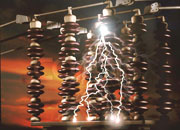Developing user friendly electricity fuel stations with the highest safety standards will be an important contribution to building up the infrastructure necessary for the wide use of electro-cars in the future.
As part of their partnership both companies are working on further developing existing concepts and standards for cable connected electricity fuel stations. In this connection E.ON has installed a newly developed electricity fuel station at the TÜV SÜD Service Centre Starnberg near Munich that is reopening, Friday 9 July. This electricity fuel station will be the first facility of this type to receive a TÜV certificate. In marketing a new generation of electricity fuel stations E.ON is specifically backing this seal of approval, thus underlining its pioneering role in developing electricity fuel stations.
TÜV SÜD and E.ON are also systematically investigating the usage possibilities and prospects of cable free charging stations. For this purpose test operations extending over several months in a test facility also installed in the Starnberg Test Centre will also put inductive charging through its paces. The test results will form an important basis for setting the first, generally applicable technical safety requirements for such charging systems. The criteria set in doing so could apply as guidelines for developing and operating such facilities worldwide in future.
Through this cooperation TÜV SÜD will strengthen its expertise throughout the electro-mobility process chain: from certifying electricity generation and safety standards for vehicles and infrastructure, up to training staff how to handle high voltage technology, as well as recycling vehicles.
For E.ON electricity fuel stations are not just charging points for electro-cars but an important interface for the intelligent electricity grids of the future. So that the increasing electricity generation from small, decentralised facilities can be integrated, energy storage has to supplement intelligent grids. One option for this is electro-cars if they could be “filled up” with electricity using an intelligent electricity fuel station when it is windy and consumption is low.
17 Декабря 2025 | среда | 12:53


